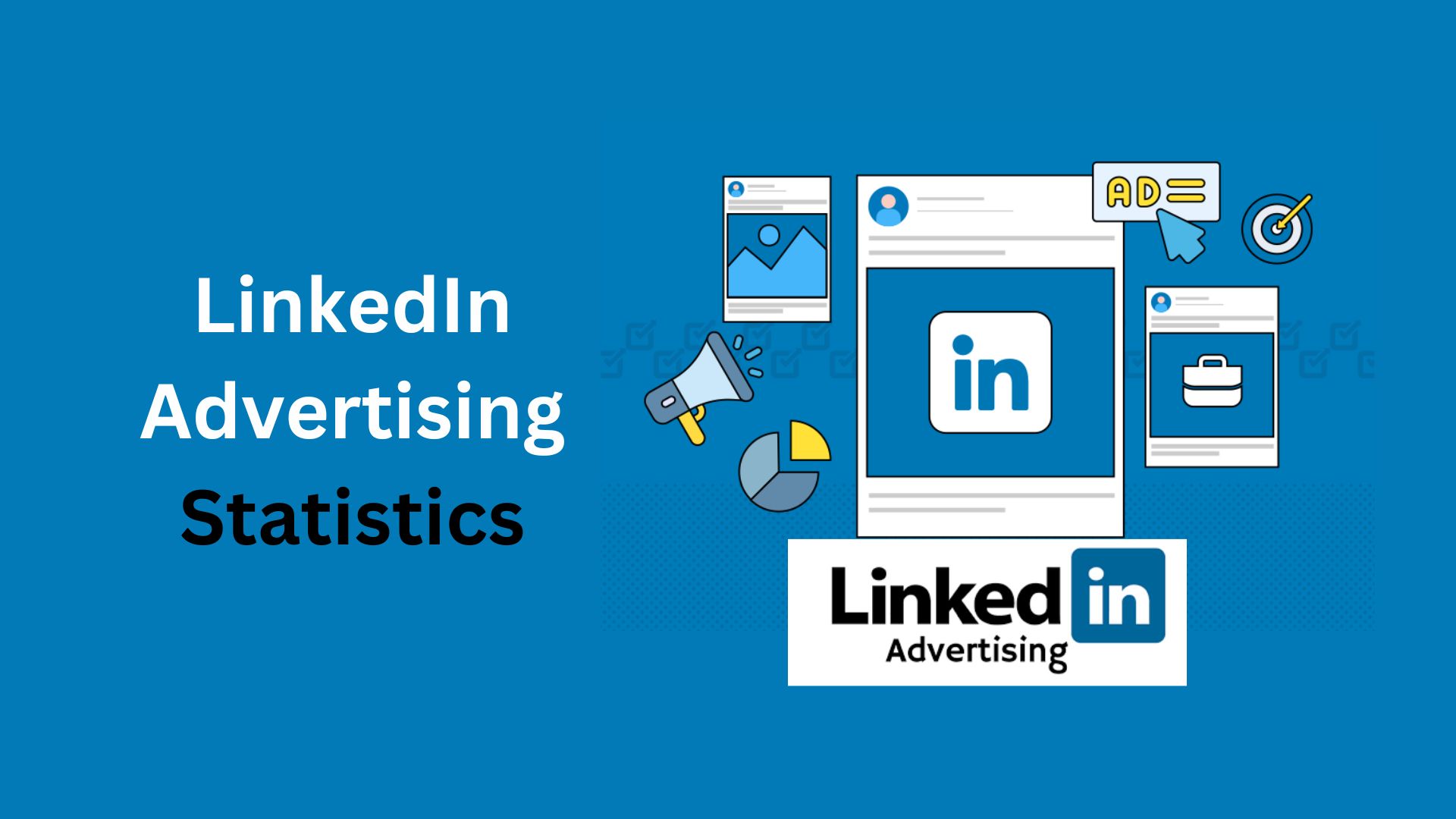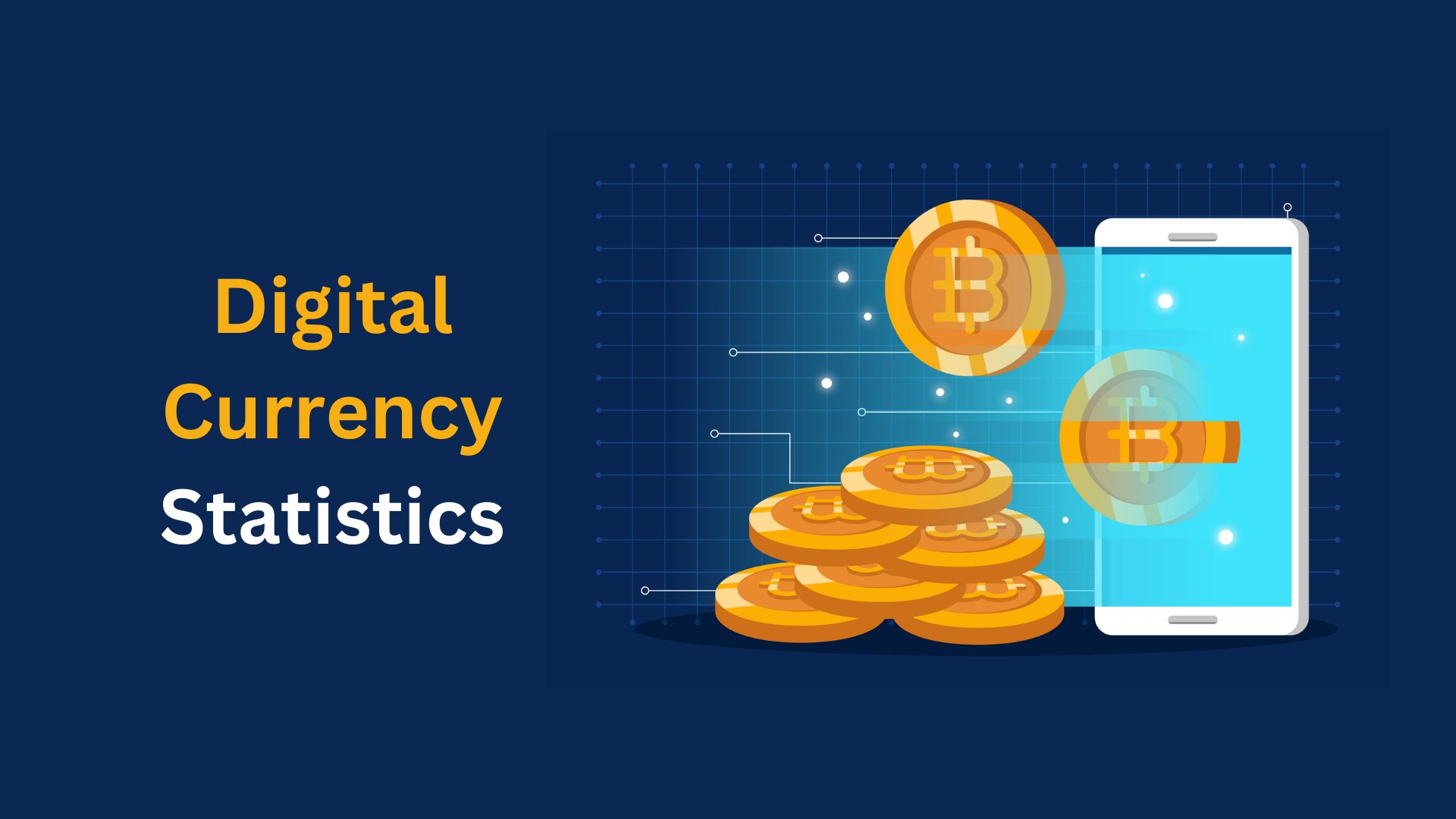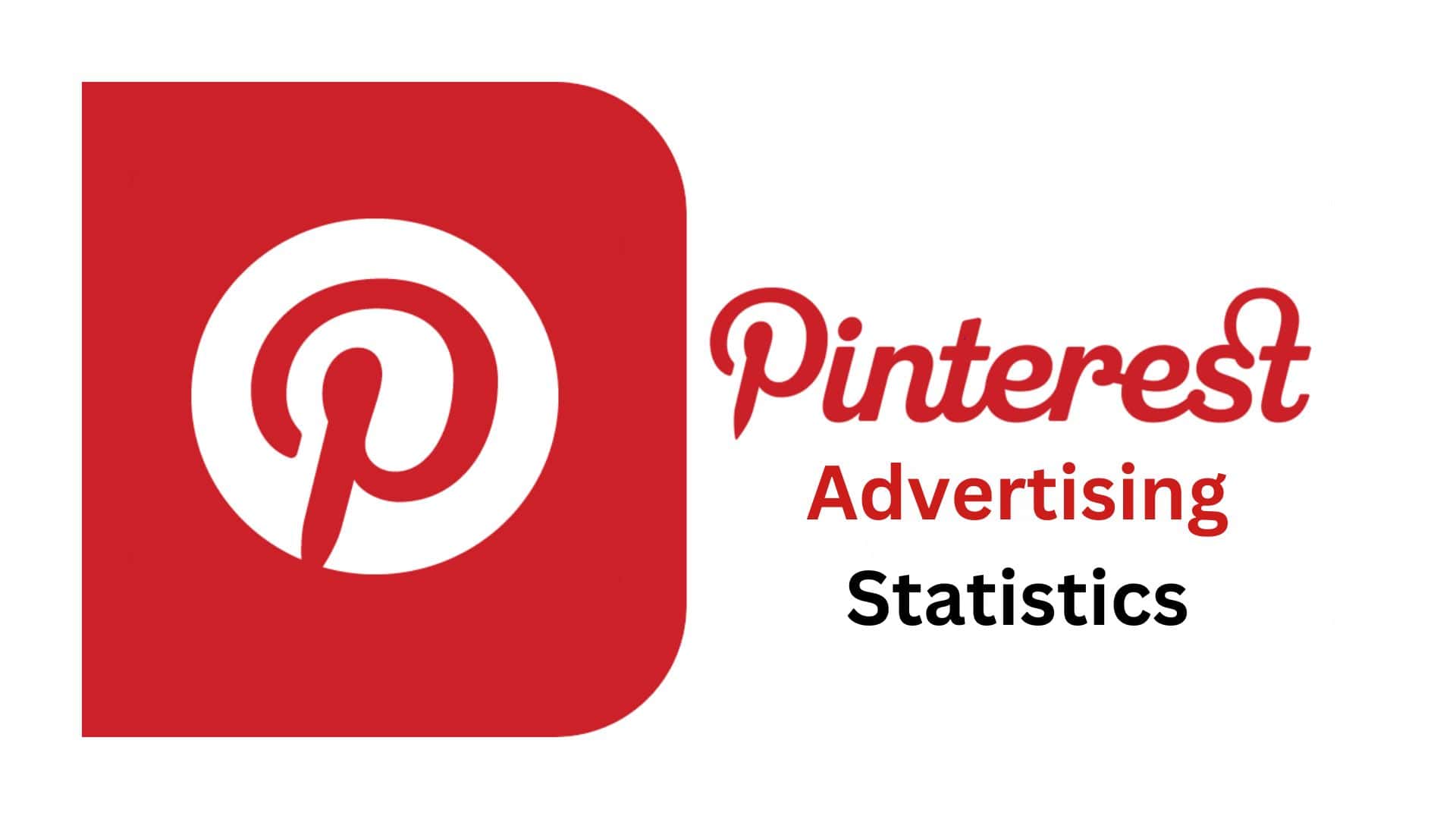Philips Statistics By Revenue, Net Sales and Facts (2025)
Updated · Nov 04, 2025
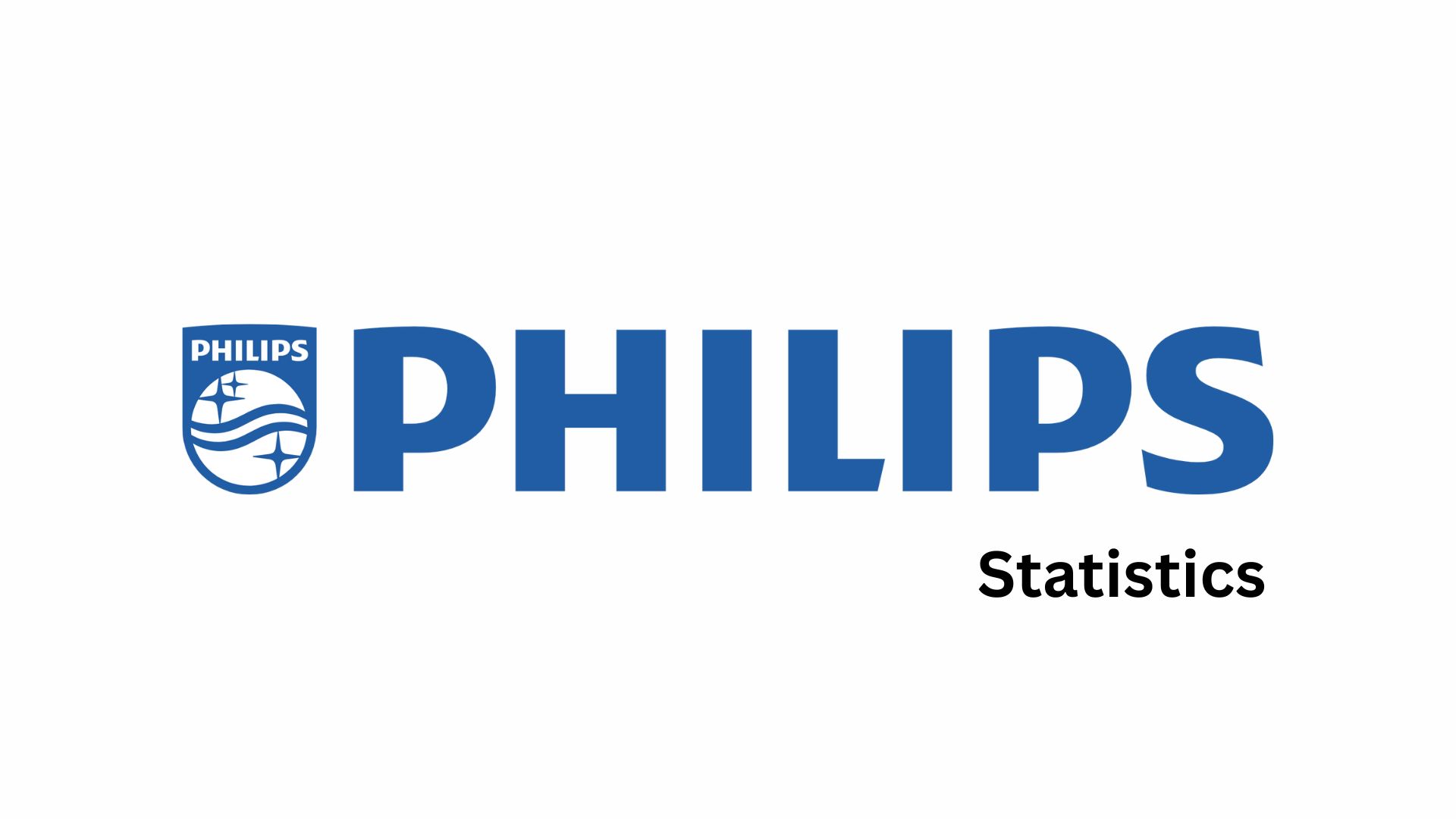
Table of Contents
- Introduction
- Editor’s Choice
- History of Philips
- Fun Facts About Philips
- Philips Net Income
- Philips EBITDA
- Philips Sales By Regions
- Q3 2025 Group Highlights
- Distribution Of Total Sales Of The Connected Care Segment Of The Philips Group In 2024, By Area Of Business
- Philip Market Cap History
- Philips Equity
- Philips NPS
- Conclusion
Introduction
Philips Statistics: Royal Philips remains the dominant player in health technology, and its era of consumer electronics is over, as the company focuses on developing medical innovations and digital healthcare solutions. The company’s 2025 performance is a combination of the difficulties encountered in the global market and the gradual unfolding of its transformation strategy.
The company’s three-pronged approach towards profitability, customer satisfaction, and shareholder value is indicative of its commitment to sustainable growth in the changing healthcare landscape. Presented below is a clear Philips statistics in 2025.
Editor’s Choice
- Sales of Philips in the second quarter of 2025 totalled €4,338 million, representing a 3% decrease from the previous quarter and a 1% increase after adjusting for the same period. This resulted in similar growth.
- Operating profit lost half its value, decreasing from €816 million to €400 million; consequently, the percentage of profit attained fell from 18% to 9% year-over-year.
- The amount of net income, on the other hand, decreased by 47% from €452 million in the second quarter of 2024 to €240 million in the second quarter of 2025, primarily due to weaker margins and the reduction of operations that were not profitable.
- The Adjusted EPS grew from €0.30 to €0.36, indicating that the company’s underlying profitability has improved notwithstanding the decrease in reported profits.
- The adjusted EBITA margin increased from 11.1% to 12.4%, while the adjusted EBITDA margin also increased from 16.4% to 17.2%, thus showing an improvement in cost efficiency.
- Sales were constant in Western Europe and North America when compared, while growth markets experienced a 2% increase, thus highlighting the demand from the emerging markets as being the strongest.
- On June 30, 2025, Philips paid a dividend of €0.85 per share on a total of 962.9 million common shares of the company, 58.56% of shareholders choosing to receive stock dividends.
- The company’s buyback plan involved purchasing a maximum of 6 million shares through forward contracts at prices ranging from €19.6 to € 20.1, set for 2027.
- Philips’ currency translation reserve was reduced by €1,580 million over the first six months of 2025, primarily due to fluctuations in the exchange rate between the USD and the euro.
- Philips’ Net Promoter Score (NPS) in 2024 was 19, which breaks down to 50% promoters, 20% passives, and 30% detractors, thus indicating moderate customer satisfaction levels.
History of Philips
- 1891: Philips & Co founded in Eindhoven by Frederik and Gerard Philips to make incandescent lamps.
- 1895: Anton Philips joins and drives commercial expansion.
- 1908: Philips Metaalgloeilampfabriek N.V. established as growth accelerates.
- 1912: Incorporated as N.V. Philips’ Gloeilampenfabrieken and listed in Amsterdam.
- 1914: Philips Research founded as the NatLab under Gilles Holst.
- 1918: Entry into medical technology with X-ray tubes.
- 1923: “Miniwatt” radio valve success sets up radio move.
- 1927: First Philips radio set (Type 2501) introduced.
- 1933: World’s largest radio manufacturer status achieved.
- 1939: Philishave rotary electric shaver launched.
- 1948–1951: 264 experimental TV broadcasts in Eindhoven support Dutch television rollout.
Wikipedia - 1951: Start of national television in the Netherlands with Philips’ technical support.
- 1963: Compact Cassette format introduced in Berlin; later licensed freely and becomes global standard.
- 1982: First commercial CDs manufactured at a Philips plant in Germany; retail launch follows.
- 1983: Philips releases the CD-100 player as CDs enter the U.S. market.
- 2012: TV business transferred into joint venture TP Vision with TPV Technology.
- 2013: Planned sale of home audio-video unit to Funai announced, later terminated.
- 2014: Corporate split announced to focus on HealthTech while separating Lighting.
- 2016: Philips Lighting listed via IPO as a step in the separation.
- 2018: Philips Lighting renamed Signify; Philips brand retained under license.
- 2021: Sale of Domestic Appliances completed to Hillhouse; proceeds about EUR 3 billion.
- 2023: Former Domestic Appliances business adopts the new corporate name Versuni while continuing to use the Philips brand under license.
- 2022–2023: Leadership transition to Roy Jakobs and a multi-year restructuring announced.
Fun Facts About Philips
- Philips was founded in 1891 in Eindhoven by Gerard Philips and his father, Frederik, to make carbon-filament lamps.
- Philips helped launch PSV Eindhoven. The club was created in 1913 for Philips employees and still plays at Philips Stadion.
- Philips and Sony co-developed the compact disc, first released in Japan in 1982. More than 200 billion CDs have been sold worldwide.
- The Compact Cassette was introduced by Philips in 1963. It was led by engineer Lou Ottens, who later worked on the CD as well.
- Philips created the first Philishave electric shaver in 1939. In the United States the shaver brand was known as Norelco.
- Philips received the right to use the “Royal” designation early in its history and began using Koninklijke Philips N.V. in its name in 1998.
- The wavy lines and stars in the Philips shield symbolize radio waves and starlight. The motif appeared in the 1920s with the company’s radios.
- Philips’ semiconductor division was spun off as NXP Semiconductors in 2006, which now operates independently.
- Philips’ lighting business became a separate company and changed its name to Signify in 2018, while continuing to use the Philips brand under license.
- The Philips-PSV partnership holds a Guinness World Record as the longest sponsorship in sporting history, dating back to 1913.
- Philips’ headquarters moved from Eindhoven to Amsterdam, with the move completed in 2001; the company continues to maintain major operations in the Eindhoven region.
- The Senseo system, launched in 2001 with Douwe Egberts, popularized single-serve coffee in Europe and sold 10 million machines by 2005.
- Philips radio heritage shaped global broadcasting. Its early design and branding around radio helped establish the famous shield used to this day.
- In recent restructuring news, Philips has continued to divest smaller chip activities, underscoring its shift to health technology.
- Eindhoven’s identity as a design hub traces in part to Philips’ industrial legacy and repurposed factory districts that now host designers and creatives.
Philips Net Income
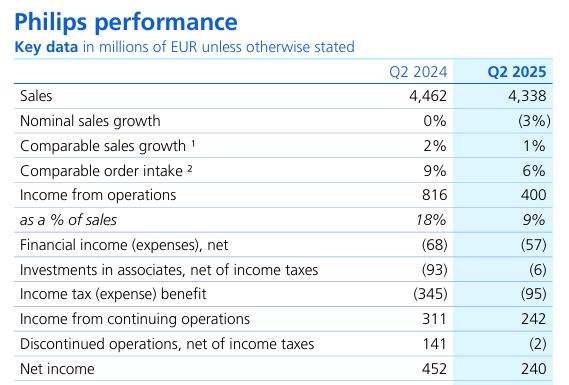
(Source: results.philips.com)
- The table presents a comparison of the financial performance of Philips for the period from the second quarter of 2024 to the second quarter of 2025.
- In the second quarter of 2024, Philips generated sales of €4,462 million, while sales in the second quarter of 2025 showed a slight decrease to €4,338 million—this was an official decline of 3%.
- The growth of sales when taking into account differences in currency and comparable factors was reduced from 2% in Q2 2024 to just 1% in Q2 2025.
- Moreover, the comparable order intake—which represents the number of new orders received by Philips—was also reduced from 9% growth in 2024 to 6% growth in 2025, indicating a positive demand but at a slower pace of growth.
- Philips’ income from operations (which is the profit before tax and interest) experienced a significant drop from €816 million in Q2 2024 to €400 million in Q2 2025.
- In terms of total sales, this represents a reduction from 18% to 9%, indicating that the operating profit was cut in half year-over-year.
- This implies that for every euro Philips earned through sales in Q2 2025, it could retain roughly 9 cents as operating profit, compared to 18 cents the previous year.
- The company’s financial income and expenses—which include interest payments and all related items—did not change much, as the net expense went down to €57 million in 2025 from €68 million in 2024.
- In the second quarter of 2025, Philips reported significantly lower investment losses, specifically €6 million from associates (compared to a €93 million loss in the previous year), indicating that the company achieved better returns from its investments in affiliates.
- The income tax paid underwent a significant reduction from €345 million in Q2 2024 to €95 million in Q2 2025, resulting in a less severe impact on weak operating income.
- After the tax deductions, the income from continuing operations or ongoing business segments dropped from €311 million to €242 million.
- A great change was witnessed in discontinued operations, which relate to the sale or exit of parts of the business by Philips.
- These units, which were sold or exited, contributed €141 million in net income in Q2 2024; however, in Q2 2025, they reported a small loss of €2 million.
- Thus, the net income—the total profit of the company after deducting all costs, taxes, and discontinued operations—decreased from €452 million in Q2 2024 to €240 million in Q2 2025.
- This signifies that Philips’ bottom line decreased by almost 47% year over year, resulting from weaker sales, lower operating margins, and smaller contributions from discontinued operations.
Philips EBITDA
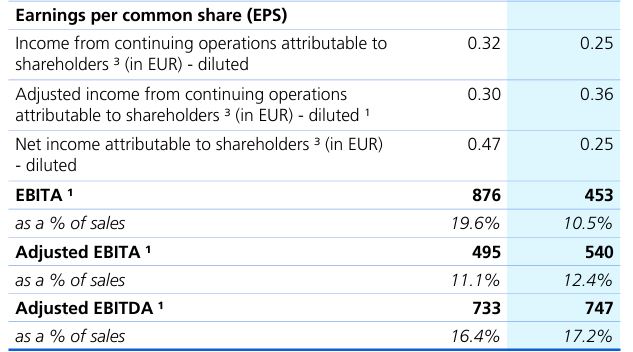
(Source: results.philips.com)
- This comparison helps to determine the changes in Philips’ profitability and earnings per share from the second quarter of 2024 to the second quarter of 2025.
- In Q2 2024, the diluted earnings per share (EPS) of Philips from continuing operations—or simply, the ongoing business activities—was €0.32.
- That number fell to €0.25 in Q2 2025, which demonstrated that less profit per share was earned from the prime operations of the company compared to the prior year.
- Nevertheless, the adjusted EPS—which disregards one-off items and provides a clearer view of the performance going on—Philips’ profits actually grew from €0.30 in 2024 to €0.36 in 2025.
- This suggests that, after removing temporary factors, the underlying profitability of the business improved slightly.
- Conversely, total net income per share—accounting for both continuing and discontinued operations—dropped considerably from €0.47 to €0.25.
- This is the same as the drop in net income reflected by the earlier data, which is also a confirmation that, overall, Philips did not earn even half the profit per share in 2025 compared to 2024.
- In the case of operating profit, Philips’ EBITA, which is the earnings before the payment of Interest, Taxes andamortisationn, dipped alarmingly from €876 million in Q2 2024 down to €453 million in Q2 2025.
- In terms of sales percentage, it is a drop from 19.6% to 10.5%, which indicates that the company’s operational strength has considerably declined over the year.
- Nevertheless, when it comes to one-off costs and special factors, the adjusted EBITA saw €495 million turning into €540 million, and the margin improved from 11.1% to 12.4%.
- The indication here is that although reported profits were down, Philips had still managed to expand its basic operations, which was the result of cost-cutting and efficiency gains in the main business.
- On the other hand, the company’s adjusted EBITDA, also known as earnings before interest, taxes, depreciation, and amortisation, showed only a slight but positive gain, going from €733 million in Q2 2024 to €747 million in Q2 2025.
- Along with this, the margin also improved from 16.4% to 17.2%, which implies that the firm was able to generate a bit more cash-based operating profit as a percent of sales than one year ago.
- To put it simply, these numbers tell a mixed story. Philips’ accounting profits and EPS were lower in Q2 2025 than in 2024, which means lower total earnings and weaker reporting.
- However, after eliminating one-off impacts, Philips reported that its underlying profitability had in fact grown, indicated by the higher adjusted EBITA and EBITDA margins.
- In other words, the figures reported were not the best ones, but at the same time, Philips’ core business did get more effective and more stable under the headline drops.
Philips Sales By Regions
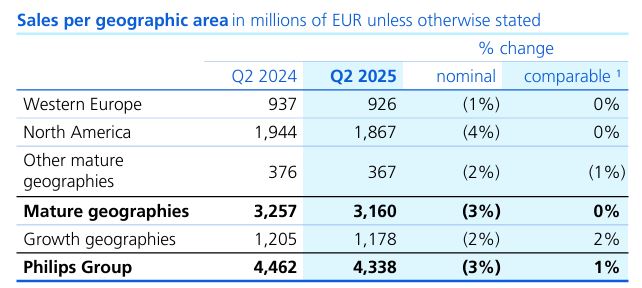
(Source: results.philips.com)
- This table presents the changes in sales of Philips in various regions from Q2 2024 to Q2 2025.
- In Western Europe, sales dropped by a small amount from €937 million in Q2 2024 to €926 million in Q2 2025, resulting in a total reduction of 1%, but when factoring in similar influences like the changes of currency and portfolio, sales remained unchanged at a 0% growth rate.
- In North America, Philips’ biggest regional market, sales went down from €1,944 million to €1,867 million, which was a 4% decrease in nominal value.
- On the other hand, the region’s sales remained the same (0%) when compared to the previous year, indicating that the drop was mainly caused by external factors like currency rates, rather than a decrease in demand or sales volume.
- In the category titled “Other mature geographies,” which consists of developed markets excluding Western Europe and North America (like Japan or Australia), sales shrank a bit from €376 million to €367 million, reflecting a nominal decline of 2% and a comparable decline of 1%.
- Combining all the mature markets—Western Europe, North America, and other developed areas—total sales dropped from €3,257 million in Q2 2024 to €3,160 million in Q2 2025, thus constituting a nominal overall decline of 3%, and a comparable growth of flat sales (0%).
- Basically, mature markets remained the same in real terms; still, they were affected by currency or other external factors.
- On the other hand, the growth markets, comprising the emerging economies in Asia, Latin America, and other underdeveloped regions, slightly outperformed the mature markets.
- Sales in those markets witnessed a nominal drop of 2% from €1,205 million to €1,178 million, but the same growth of 2% indicates that the business activity in these areas actually stretched once adjusted for external factors.
- For the Philips Group, total sales dropped from €4,462 million in Q2 2024 to €4,338 million in Q2 2025. This results in 3% nominal decline but 1% comparable increase.
- Hence, the company’s reported revenues being less than before due to currency or divestment effects, it has still gained modest real growth in its core business operations.
Q3 2025 Group Highlights
According to Philips’ Q3 2025 financial report:
- The company recorded 8% growth in comparable order intake, supported by strong performance in North America.
- Group sales reached EUR 4.3 billion, marking a 3% increase in comparable sales from the previous year.
- Income from operations stood at EUR 330 million, reflecting steady operational performance.
- The adjusted EBITA margin improved by 50 basis points to 12.3%, mainly driven by higher sales and productivity initiatives.
- Philips generated an operating cash flow of EUR 327 million and a free cash flow of EUR 172 million.
- The company reaffirmed its full-year 2025 outlook, expecting the margin to remain at the upper end of the 11.3%–11.8% range.
As reported, group and segment performance was as follows:
- Overall comparable sales rose by 3.3%, reflecting growth across all key business segments.
- Margin expansion was supported by productivity and a favorable product mix that balanced the impact of higher tariffs.
- Free cash flow increased to EUR 172 million, showing improved cash generation efficiency.
- In the Diagnosis & Treatment segment, comparable sales grew 1.3%. The adjusted EBITA margin reached 11.8%, down 80 basis points, mainly due to tariff-related pressures despite gains from new innovations and productivity.
- The Connected Care segment reported 5.1% growth in comparable sales. Its adjusted EBITA margin improved sharply by 410 basis points to 11.4%, supported by sales growth and cost efficiency, partially offset by tariffs. This also included a one-time gain from a minority investment.
- The Personal Health segment recorded the strongest growth, with 10.9% higher comparable sales. Its adjusted EBITA margin rose by 60 basis points to 17.1%, mainly due to higher sales volumes and productivity gains.
- According to the report, Philips achieved EUR 222 million in productivity savings during the quarter through disciplined cost management. The company remains on track to deliver its EUR 2.5 billion productivity program over three years, with EUR 800 million expected in 2025.
In terms of profitability and income:
- Adjusted EBITA rose to EUR 531 million, resulting in a margin of 12.3%, supported by sales growth and cost improvements.
- Restructuring, acquisition, and other related costs totaled EUR 122 million, including EUR 57 million for restructuring, EUR 20 million for field actions, and EUR 23 million for quality measures.
- Net income reached EUR 187 million, mainly driven by higher earnings, lower financial expenses, and improved investment income.
Segment insights included:
- In Diagnosis & Treatment, growth was driven by Image Guided Therapy and Precision Diagnosis. Mature markets grew modestly, while emerging markets remained stable.
- In Connected Care, strong double-digit growth in the Monitoring category supported performance across regions.
- In Personal Health, double-digit growth in emerging markets and mid-single-digit gains in mature markets boosted the segment’s results.
Outlook for 2025, as reiterated by Philips:
- Comparable sales growth is expected between 1% and 3%.
- Adjusted EBITA margin projected between 11.3% and 11.8%, trending toward the higher end.
- Free cash flow forecasted between EUR 0.2 billion and EUR 0.4 billion, including payouts related to the Philips Respironics settlement in the U.S.
Distribution Of Total Sales Of The Connected Care Segment Of The Philips Group In 2024, By Area Of Business
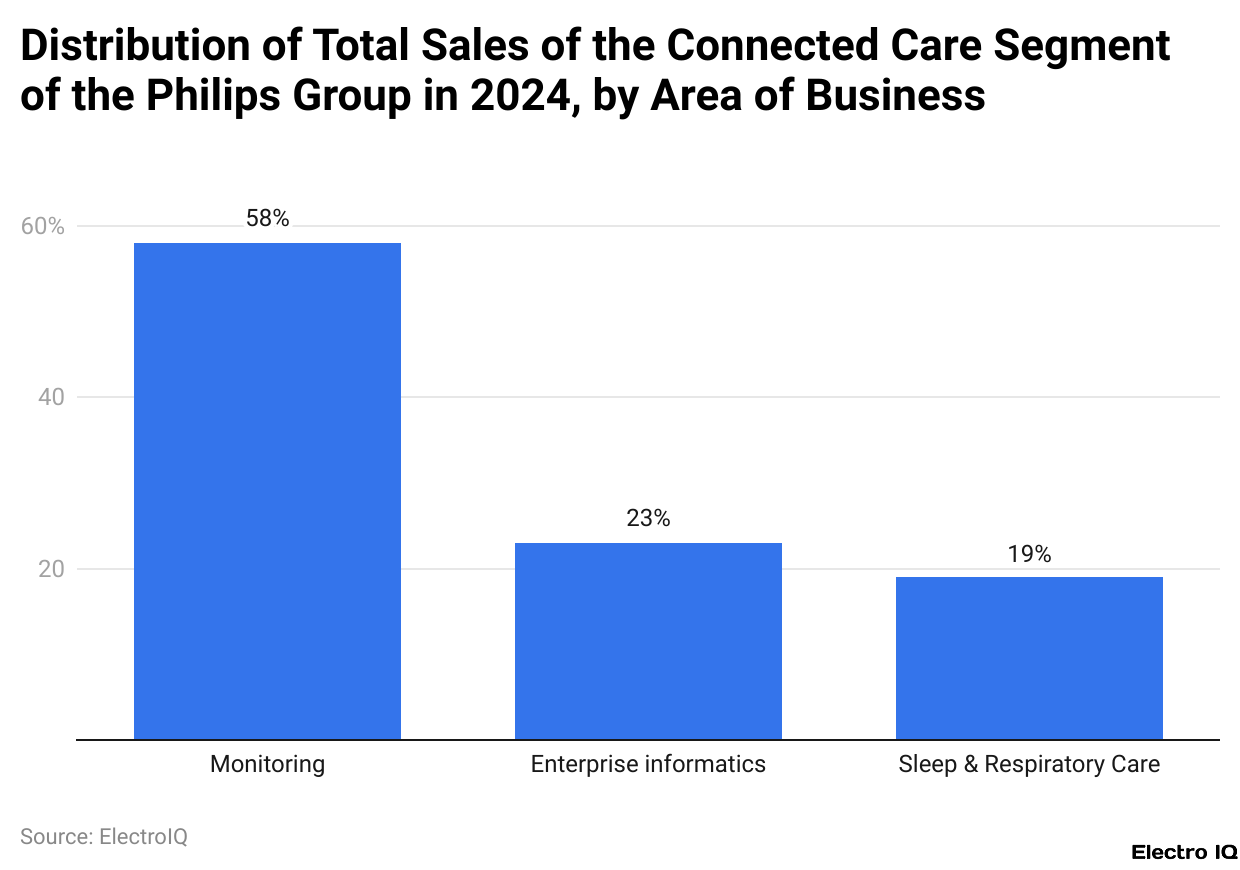
(Reference: statista.com)
- In 2024, the Connected Care and Health Informatics segment of the Philips Group received most of its revenue from monitoring, which represented 58% of the total sales.
- This indicates that monitoring solutions like patient monitoring systems and associated technologies have become the most significant contributors to the healthcare business of the company.
- After the divestiture of a few non-healthcare product categories, Koninklijke Philips N.V. is now mainly focused on medical technology, stressing digital health solutions, patient care systems, and connected healthcare innovations.
Philip Market Cap History
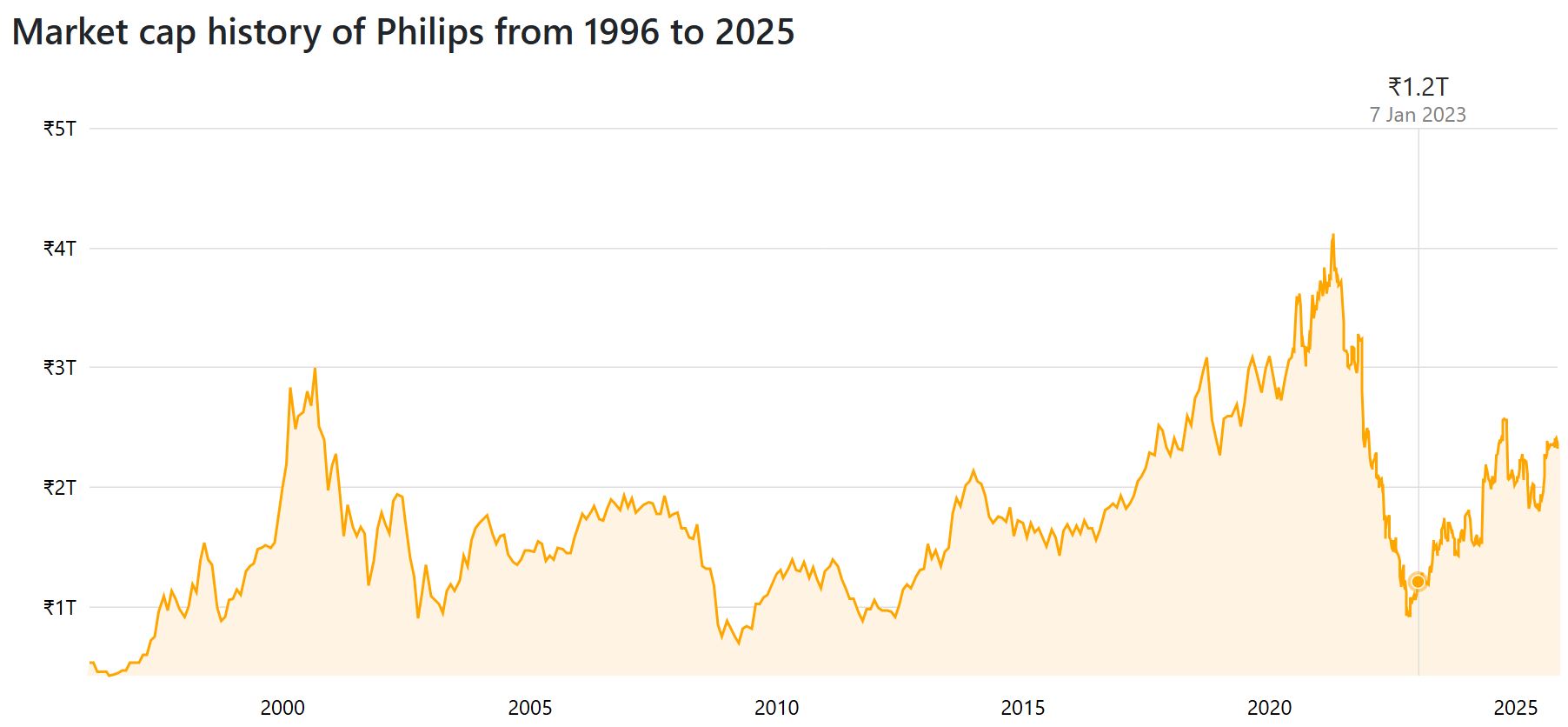
(Source: companiesmarketcap.com)
- The graph presents the ups and downs of Philips’ market capitalization over the last five years.
- The company’s stock market value was at ₹2.402 trillion in 2021, which, however, plummeted by 32.91% in the following year to the level of ₹1.098 trillion, indicating a drastic decrease in either the investors’ trust or the performance of the market.
- The company witnessed a gradual healing process starting from 2023 onwards. It had already added about 61.56% to its market cap in 2023, taking it to ₹1.774 trillion, and thereafter, it was about a 15% increase during 2024 and 2025, which brought the company’s market cap to ₹2.353 trillion.
- This pattern shows that the firm, after facing the past slump, has become stable and trustworthy to the investors again.
Philips Equity
- By the end of the second quarter 2025, Philips had a total of 962,920,132 common shares outstanding, each with a nominal value of EUR 0.20.
- The firm also possessed 12,345,653 treasury stock, purchased at an average price of EUR 26.66 per share through buyback programs.
- A dividend of EUR 0.85 per share, which could be paid in cash or in additional shares, was approved by the shareholders on May 8, 2025.
- The stockholder who represented 58.56% of the total population opted to take shares, and consequently, 22,980,748 new shares were created, whereas the part paid in cash amounted to EUR 328 million.
- Philips, on June 3, 2025, announced a buyback scheme of up to 6 million shares in connection with the company’s long-term incentive plans.
- These repurchased shares would be accomplished by entering three forward contracts with a financial institution.
- 2 million shares for each contract, which will be settled between February and December 2027 at an average price of EUR 19.6-20.1.
- The company’s currency translation reserve decreased by EUR 1,580 million in the first half of 2022, primarily due to fluctuations in the USD-EUR exchange rate.
Philips NPS
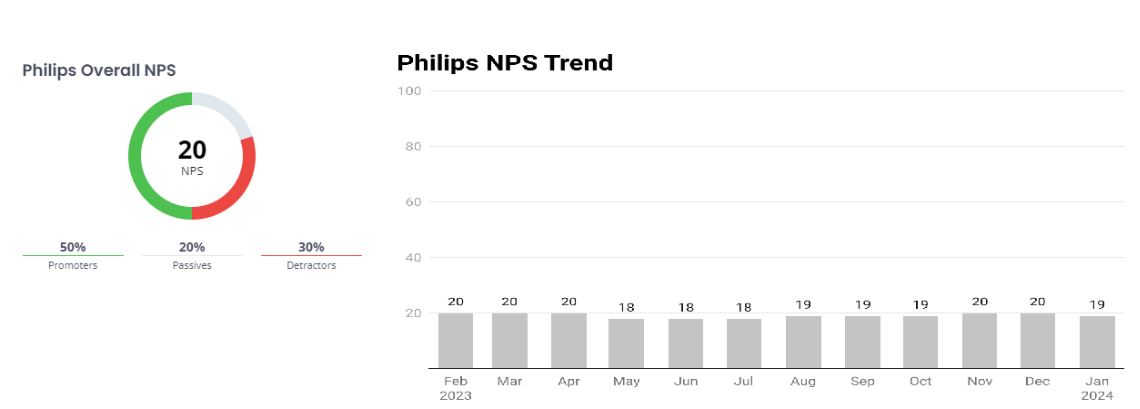
(Source: coolest-gadgets.com)
- Philips scored an NPS of 19 in January 2024, indicating that customer satisfaction was slightly above the middle.
- The NPS was comprised of 50% promoters, who recommended the brand, 20% neutral passives, and 30% detractors.
- The female customers rated Philips higher and gave an NPS of 14, while male customers rated it lower with 4, thus revealing a marked difference in brand awareness.
- Results by ethnicity showed that loyalty among the African American/Black customers was much stronger, er with an NPS of 42, followed by 34 for both the Asian or Pacific Islander and the Hispanic or Latino customers.
- Caucasian customers, on the other hand, gave a bad NPS of -34, while others gave a low rating of -5, implying that the customer experience might need to be improved across all races.
- Furthermore, customer loyalty was closely tied to how long Philips products had been in use.
- The longest users, those who had used Philips products for 5 to 10 years, gave the highest NPS of 35, indicating high satisfaction among long-term users.
- Customers with 2 to 5 years of experience rated 18, while long-term users of over a decade rated only 5.
- New customers with less than one year (-5) or between one and two years (-4) of experience reported negative NPS scores, which suggests a problem with increasing early-stage customer loyalty.
Conclusion
Philips Statistics: The transformation process at Philips, which is currently underway, reflects the company’s commitment to developing healthcare technology and enhancing its operational efficiency. The company’s main focus has been on digital health, patient monitoring, and connected care solutions, and it has been able to maintain this focus even during times of fluctuating revenue and profitability.
Consistent interaction with shareholders, market stability, and customer loyalty all helped Philips remain flexible and adapt. The company is determined to innovate and create long-term value, which means it is well-positioned to maintain a sustainable presence in the healthcare tech market, thus confirming its role as a reliable name in medical and digital health.
FAQ.
Philips’ Q2 sales in 2025 amounted to €4,338 million or a 3% drop from 2024, but on a like-for-like basis, sales went up by 1%. Operating profit was severely hard, going down from €816 million to €400 million, which in turn had an effect of reducing the margin from 18% to 9%. Nevertheless, the company was able to report a rise of adjusted EPS from €0.30 to €0.36, as well as increases in both adjusted EBITA (12.4%) and EBITDA (17.2%) margins, which indicated that the company was becoming more efficient in its cost management.
The sales in Western Europe and North America have not changed, whereas the emerging markets like Asia and Latin America have seen an increase of 2%. The mature markets experienced a nominal decline of 3%; however, the demand in the growing regions has been strong, and the rest of the world has definitely not run out of customers.
After the market value dropped by 32.91% in 2022, Philips, on the other hand, had a steady rise, with the market capitalization going from ₹1.098 trillion in 2023 to ₹2.353 trillion by 2025. This represented a 15% increase for two years in a row, which was a sign of the investors’ trust being restored.
The NPS of 19 is an indication of moderate satisfaction as per Philips, and it also points out some customers’ strong loyalty—their long-term users as well as certain groups—while at the same time it shows the weak engagement that the company has with the new and Caucasian customers.
Philips announced a dividend of €0.85 per share and sold back 6 million shares; at the same time, the company managed to stay strong financially even when it faced losses due to currency fluctuations.

I hold an MBA in Finance and Marketing, bringing a unique blend of business acumen and creative communication skills. With experience as a content in crafting statistical and research-backed content across multiple domains, including education, technology, product reviews, and company website analytics, I specialize in producing engaging, informative, and SEO-optimized content tailored to diverse audiences. My work bridges technical accuracy with compelling storytelling, helping brands educate, inform, and connect with their target markets.


